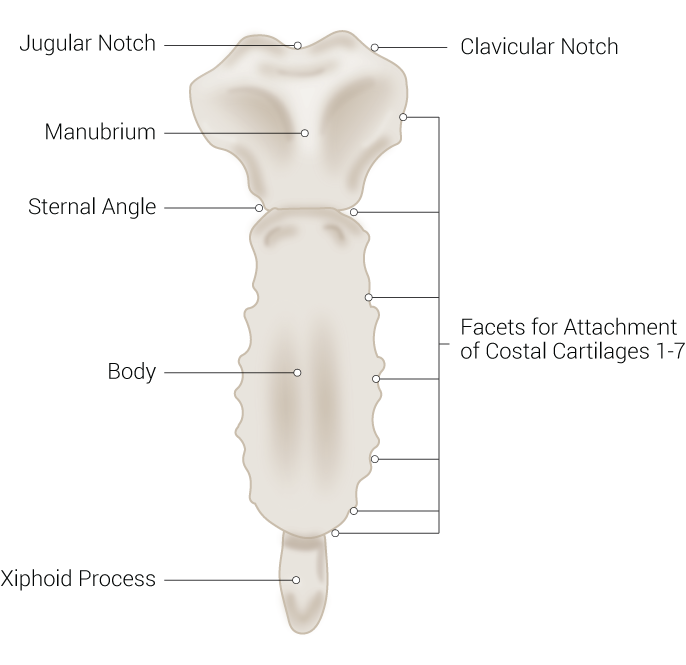[2]
Mashriqi F, D'Antoni AV, Tubbs RS. Xiphoid Process Variations: A Review with an Extremely Unusual Case Report. Cureus. 2017 Aug 27:9(8):e1613. doi: 10.7759/cureus.1613. Epub 2017 Aug 27
[PubMed PMID: 29098125]
Level 2 (mid-level) evidence
[3]
Nam S, Cho W, Cho H, Lee J, Lee E, Son Y. Xiphoid process-derived chondrocytes: a novel cell source for elastic cartilage regeneration. Stem cells translational medicine. 2014 Nov:3(11):1381-91. doi: 10.5966/sctm.2014-0070. Epub 2014 Sep 9
[PubMed PMID: 25205841]
[4]
Adams L, Pace N, Heo A, Hunter I, Johnson AW, Mitchell UH. Internal and External Oblique Muscle Asymmetry in Sprint Hurdlers and Sprinters: A Cross-Sectional Study. Journal of sports science & medicine. 2022 Mar:21(1):120-126. doi: 10.52082/jssm.2022.120. Epub 2022 Feb 15
[PubMed PMID: 35250341]
Level 2 (mid-level) evidence
[5]
Hawkins SP, Hine AL. Diaphragmatic muscular bundles (slips): ultrasound evaluation of incidence and appearance. Clinical radiology. 1991 Sep:44(3):154-7
[PubMed PMID: 1914388]
[6]
Simpson JK, Hawken E. Xiphodynia: a diagnostic conundrum. Chiropractic & osteopathy. 2007 Sep 15:15():13
[PubMed PMID: 17868466]
[7]
Hogerzeil DP, Hartholt KA, de Vries MR. Xiphoidectomy: A Surgical Intervention for an Underdocumented Disorder. Case reports in surgery. 2016:2016():9306262
[PubMed PMID: 27900228]
Level 3 (low-level) evidence
[8]
Zalel Y, Lipitz S, Soriano D, Achiron R. The development of the fetal sternum: a cross-sectional sonographic study. Ultrasound in obstetrics & gynecology : the official journal of the International Society of Ultrasound in Obstetrics and Gynecology. 1999 Mar:13(3):187-90
[PubMed PMID: 10204210]
Level 2 (mid-level) evidence
[9]
El-Busaid H, Kaisha W, Hassanali J, Hassan S, Ogeng'o J, Mandela P. Sternal foramina and variant xiphoid morphology in a Kenyan population. Folia morphologica. 2012 Feb:71(1):19-22
[PubMed PMID: 22532180]
[10]
Berdajs D, Zünd G, Turina MI, Genoni M. Blood supply of the sternum and its importance in internal thoracic artery harvesting. The Annals of thoracic surgery. 2006 Jun:81(6):2155-9
[PubMed PMID: 16731146]
[11]
Shahoud JS, Kerndt CC, Burns B. Anatomy, Thorax, Internal Mammary (Internal Thoracic) Arteries. StatPearls. 2024 Jan:():
[PubMed PMID: 30726022]
[13]
Mitchell AU, Torup H, Hansen EG, Petersen PL, Mathiesen O, Dahl JB, Rosenberg J, Møller AM. Effective dermatomal blockade after subcostal transversus abdominis plane block. Danish medical journal. 2012 Mar:59(3):A4404
[PubMed PMID: 22381092]
[14]
Rashed A, Verzar Z, Alotti N, Gombocz K. Xiphoid-sparing midline sternotomy reduces wound infection risk after coronary bypass surgery. Journal of thoracic disease. 2018 Jun:10(6):3568-3574. doi: 10.21037/jtd.2018.06.20. Epub
[PubMed PMID: 30069354]
[15]
Mihmanlı M, Köksal HM, Demir U, Işıl RG. Benefits of xiphoidectomy in total gastrectomy: Technical note. Ulusal cerrahi dergisi. 2016:32(1):47-9. doi: 10.5152/UCD.2015.2817. Epub 2015 Jun 24
[PubMed PMID: 26985158]
[16]
Kusunoki S, Tanigawa K, Kondo T, Kawamoto M, Yuge O. Safety of the inter-nipple line hand position landmark for chest compression. Resuscitation. 2009 Oct:80(10):1175-80. doi: 10.1016/j.resuscitation.2009.06.030. Epub 2009 Jul 31
[PubMed PMID: 19647360]
[17]
Bayaroğulları H, Yengil E, Davran R, Ağlagül E, Karazincir S, Balcı A. Evaluation of the postnatal development of the sternum and sternal variations using multidetector CT. Diagnostic and interventional radiology (Ankara, Turkey). 2014 Jan-Feb:20(1):82-9. doi: 10.5152/dir.2013.13121. Epub
[PubMed PMID: 24100061]
[18]
Beydilli H, Balci Y, Erbas M, Acar E, Isik S, Savran B. Liver laceration related to cardiopulmonary resuscitation. Turkish journal of emergency medicine. 2016 Jun:16(2):77-79
[PubMed PMID: 27896328]
[19]
Yapici Ugurlar O, Ugurlar M, Ozel A, Erturk SM. Xiphoid syndrome: an uncommon occupational disorder. Occupational medicine (Oxford, England). 2014 Jan:64(1):64-6. doi: 10.1093/occmed/kqt132. Epub 2013 Dec 11
[PubMed PMID: 24336479]

